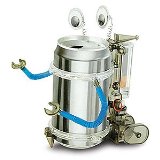 In this HowTo we will cover the very basics of getting your site included on major search engines.
In this HowTo we will cover the very basics of getting your site included on major search engines.
Although every search engine uses its own software and algorithms to process your pages there are standards that are common and should be followed if you want your sites pages to be included and placed well within search result pages.
First lets look at in-site linking
When you are developing your site you must take into consideration how a search engine robot will see your page.
Although pretty graphics for menus are fine for people …. robots will not see images that are linked.
For that reason flash menu systems should also provide a nonscript version with your full menu.
When generating links it is important to provide descriptive text.
If you do need to use a graphical menu system then also include alt and title tags that are descriptive.
Also some software will provide the ability to embed text within image files. For the most part this information will be rejected but you may want to include it for copyright or other reasons.
Dynamic Links ?
Most search engines including Google recommend that you do not generate links that contain a Question Mark such as www.site.com/?p=123 .
If you are using a blog system such as WordPress or Drupal or even generating the content with custom scripts you should use a fully structured link.
Most Blog software will include a Permalink structure setting that can be used to generate page urls on the fly.
The Number of Links On A Page
Pages with too many links can be rejected even if those links are to internal documents.
For this reason even if you are building a visitor site map you should keep the maximum number of links on a page to well under 100.
Examine your site with a Text Only Browser
A way to understand how your site may look to a search engine robot is by using a text only browser.
Unix users can use Lynx and windows users can download a ported version.
Doing so will not give you all the information that a robot will harvest but it is an eye opener if your site is one that makes use of a lot of script and multimedia formatting.
Keywords and Search Engine Optimization
You should build your content for your visitors first. For many years search engine developers have been testing all of the different factors that can effect rank.
When Search Engines became a valued resource and one where businesses could make money people useto develop content to fool search engines. They would make pages that would rank high with misleading links and titles and direct innocent searchers to often strange and sometimes dangerous content.
After page rank became unreliable engineers turned to other methods to sort out this phantom content.
Eventually methods got good enough that you can now pretty much get what you are looking for within the first page of a search.
Tricking bots by designing content and feeding them based on their ip domain or type will not really work.
Use Titles
Use Keywords in your Paragraph <H> headings.
Use keywords in your content.
Do Not fill the page with random keywords
Do Not Use small or hidden keyword text
Do Not Use Doorway pages
And try to have a few hundred words of content on each page.
Final Note
Search Engines are getting pretty good at weeding out garbage content… All you have to do is go to one and see the quality of content and links you retrieve on an average search.
For your site to get popular you need content.
The more content that you add the more links and pages that can be included in search Engine Indexes.
Don’t worry about duplicate links on your site but you should not duplicate content.
So the best practice is just get writing and do a lot of it.
And remember to submit your websites sitemap.xml file to google and other search engines.




